GHS
- Introduction to GHS
- GHS Hazard Class and Hazard Category
- GHS Signal Word
- GHS Pictogram
- GHS Hazard Statement
- GHS Precautionary Statement
- GHS Label Element
- GHS Safety Data Sheet
- UN GHS Purple Book
- GHS Precedence Rules for Pictogram, Signal Word and Hazard Statement
- GHS Classification of Mixture
- GHS Bridging Principles
- GHS Cut-off value/concentration Limit
- Global GHS Label Size Requirement
- Global GHS Implementation 2016
- Global GHS Label Requirement for Small Containers
- GHS and Pesticides
Intro to the Globally Harmonized System of Classification and Labelling of Chemicals (GHS)
By Little Pro on 1 Jan 2015. Updated on 14 March 2018
The Globally Harmonized System of Classification and Labelling of Chemicals (GHS) is a system developed by the United Nations for standardizing and harmonizing the classification and labelling of chemicals globally. More specifically, the UN GHS Document (known as UN GHS Purple Book):
- Defines physical, health and environmental hazards of chemicals and harmonizes classification criteria;
- Standardizes the content and format of chemical labels and Safety Data Sheets.
The UN GHS purple book is updated frequently and the latest version was the 7th revised edition released in 2017.
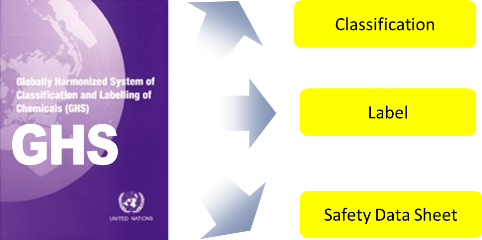
As a voluntary international system, the GHS is not legally binding in any country. Therefore, countries adopting GHS have to issue their own regulations or standards to implement GHS criteria and provisions. Two examples are:
- The EU CLP REGULATION (EC) No 1272/2008 on Classification, Labelling and Packaging of Substances and Mixtures;
- OSHA's Hazard Communication Standard (HCS) 2012 in the United States;
Benefits of GHS Adoption
Compared to pre-GHS hazard communication, GHS offers better protection to workers and users and facilitates international chemical trade.
In pre-GHS era, users may see different label warnings or safety data sheet information for the same chemical, which can cause confusion. In addition to that, most of countries have their own hazard classification and labelling regulations in pre-GHS era. Those regulations vary significantly and compliance with them is very costly and time-consuming.
Scope of UN GHS and Applicable Industry Sectors
The GHS covers all hazardous chemicals, i.e., chemicals meeting the criteria for a hazard class in the GHS. Sectors that may adopt GHS include:
| Transport |
Workplace
|
| Consumer
|
| Pesticides
|
| |
Some countries have adopted GHS in all 4 sectors while other countries have only adopted GHS in 1 or 2 sectors. To check if your products require GHS labelling or Safety Data Sheets, you need to check whether your country has adopted GHS or not and which sector is applicable (if yes).
Pharmaceuticals, food additives, cosmetics and pesticide residues in food are not covered by the UN GHS (referring to chapter 1.1 of the UN GHS) at the point of consumption, but will be covered where workers may be exposed (workplaces), and in transport. Articles and foods are also usually out the scope of GHS.
GHS Hazard Class, Hazard Category and Hazard Pictogram
GHS describes the nature and severity of a chemical hazard by hazard class and hazard category. GHS also assigns standard pictograms representing different types of hazards.
- Hazard class: the nature of a chemical hazard, i.e., flammable liquids, carcinogen.
- Hazard category: the division of criteria within each hazard class. For example, flammable liquids have 4 categories among which flammable liquids category 1 represents the most severe hazard.
- Hazard pictogram: 9 pictograms conveying different types of health, physical and environmental hazards;
There are 29 hazard classes in the latest version of UN GHS ( UN GHS Rev. 7). A chemical meeting the criteria for any hazard class below will be regarded as a hazardous chemical.
| Physical Hazards(17 classes) |
Health Hazards(10 classes)
|
| Environmental Hazards(2 classes)
|
| |
It shall be noted that the GHS allows individual countries or regions to choose which hazard classes or hazard categories to implement to meet their domestic needs. For example, EU has not adopted flammable liquids category 4. The United States has not adopted Hazardous to the Ozone Layer yet. This is often called GHS Building Blocks approach.
The picture below shows the type of chemical hazards each GHS pictogram represents. By clicking the picture below, you can download GHS pictograms and make your own GHS posters. The document is editable.
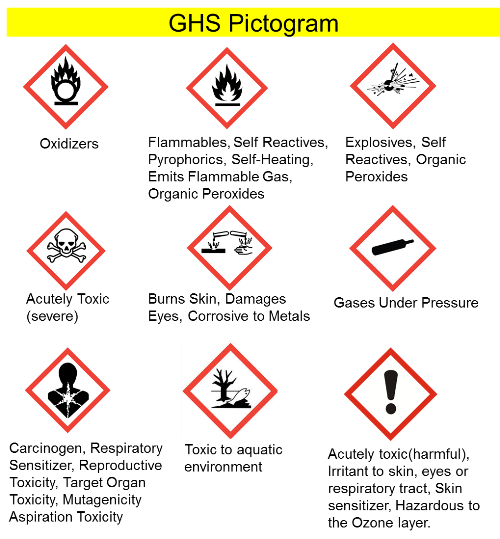
GHS Classification
GHS classification is a process to determine the hazard class and category of a chemical (substance or mixture) in accordance with GHS hazard classification criteria.
The picture below is an example of GHS classification criteria for flammable liquids. A liquid with a flash point between 23 and 60 Celsius degrees will be classified as flammable liquid category 3. A liquid with a flash point above 93 Celsius degrees does not meet GHS classification criteria and will not be regarded as a hazardous chemical.

Download GHS Classification Criteria
- Classification criteria for physical hazards;
- Classification criteria for health hazards;
- Classification criteria for environmental hazards.
Classification Determines Labelling Elements
Once a chemical has been classified according to GHS classification criteria, you can easily find assigned signal word, pictogram, hazard statements and precautionary statements that need to be included on labels and in SDSs.
For example, a liquid with a flash point between 23 and 60 Celsius degrees will be classified as flammable liquid category 3. By checking the page 316 of above document, you can easily find out the core labelling elements for this liquid:
- Signal word: Warning;
- Pictogram: Flame;
- Hazard statement: H226 flammable liquid and vapour;
- Precautionary statement: P210, P233, P280, P303+P361+P353, P370+P378, P403+P235, P501;
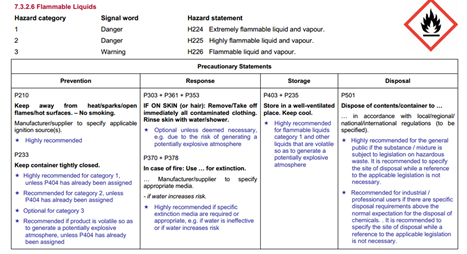
How to Classify Substances and Mixtures under GHS
Classification is very important but not easy. For substances, you need to have test data to carry out classification. Luckily you do not need to test every substance. Many countries or regions have published compulsory or advisory GHS classification lists for pure substances. You can directly refer to those classifications for your substances without doing the tests.
The most well-known GHS classification list is the annex VI of EU CLP regulation. It includes compulsory GHS classifications for thousands of substances.
For mixtures, you may take advantages of bridging principles or calculation methods or concentration limits to classify them.
Read more about GHS classification of mixture.
GHS Label
The core elements of a GHS label include:
- Product identifier: Chemical identities of a substance or hazardous ingredients in a mixture;
- Supplier identification: The name, address and telephone number of a supplier;
- Signal word: Danger or Warning;
- Hazard pictogram: conveying different types of chemical hazards;
- Hazard statements: standardized and assigned phrases that describe the hazard(s) as determined by hazard classification;
- Precautionary statements: standardized phrases that describe measures to minimize or prevent adverse effects;
An example of a GHS label for a chemical can be found below:
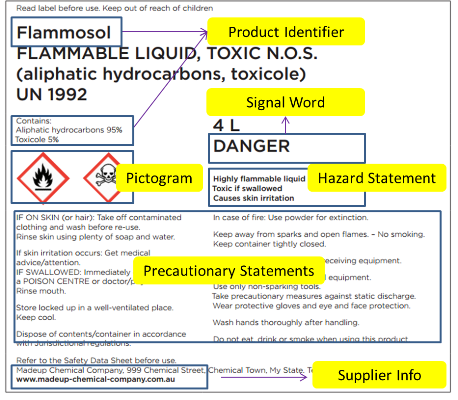
Please be noted that:
- Some countries may require supplementary information on labels (i.e. quantity, 24h emergency telephone number, expiration date, instruction for uses, etc.);
- For a chemical classified with multiple hazards, there are precedence rules for signal word, pictogram and hazard statements;
- In case of small containers and awkward packaging, some GHS label elements may be omitted(for example, China);
- Many countries have set the minimum size requirement on a GHS label or a pictogram or even font size (A Comparison of GHS label size requirements 2015);
- Some countries or regions have limited the number of precautionary statements to make a label more readable. For example, EU CLP labels.
Safety Data Sheet (SDS)
Safety Data Sheet (SDS), also called as Material Safety Data Sheet (MSDS) in pre-GHS era, is a very important document to inform its audience of the hazards of a substance or mixture and provide advice on safety precautions.
An SDS should be prepared and provided for a substance or mixture meeting classification criteria for a hazard class or for a mixture containing an ingredient meeting criteria for carcinogenic, toxic to reproduction or specific target organ toxicity exceeding the cut-off value limits given in the following table.
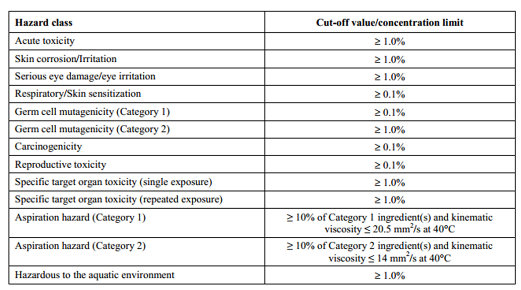
GHS has harmonized the format and content of Safety Data Sheets. There are 16 sections in standard GHS SDSs (as shown below). GHS has also set the minimum info required for each section.
- Section 1 Identification of the substance or mixture and of the supplier;
- Section 2 Hazard identification;
- Section 3 Composition/information on ingredients;
- Section 4 First-aid measures;
- Section 5 Fire-fighting measures;
- Section 6 Accidental release measures;
- Section 7 Handling and storage;
- Section 8 Exposure controls/personal protection;
- Section 9 Physical and chemical properties;
- Section 10 Stability and reactivity;
- Section 11 Toxicological information;
- Section 12 Ecological information;
- Section 13 Disposal consideration;
- Section 14 Transport information;
- Section 15 Regulatory information;
- Section 16 Other information.
Please be noted that:
- An SDS usually needs to be prepared in the language of its destination country;
- Some countries may have set additional requirements on some sections of SDSs (for example, information disclosure in section 3, occupational exposure limits in section 8, regulatory info in section 15);
GHS Implementation
Many countries/regions have adopted GHS such as the United States, EU, China and Japan. By clicking the links below, you can find detailed info about how GHS is adopted in each country/region.
- GHS in EU/CLP
- GHS in USA
- GHS in Switzerland
- GHS in Turkey
- GHS in Australia
- GHS in Canada
- GHS in Brazil
- GHS in China
- GHS in Korea
- GHS in Japan
- GHS in Taiwan
- GHS in Singapore
- GHS in Indonesia
- GHS in Malaysia
- GHS in Thailand
- GHS in Vietnam
- GHS in Philippines
- GHS in New Zealand
- GHS in Other Countries
References